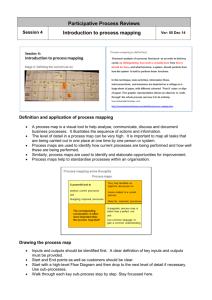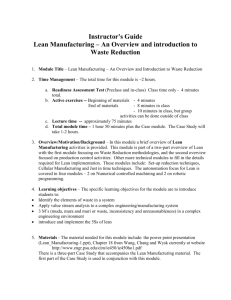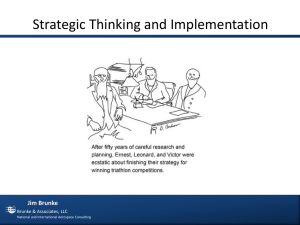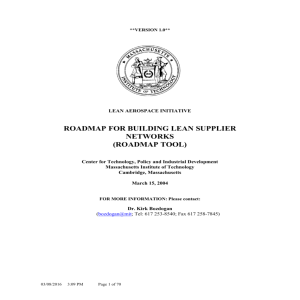The Evolution of Risk Management
advertisement
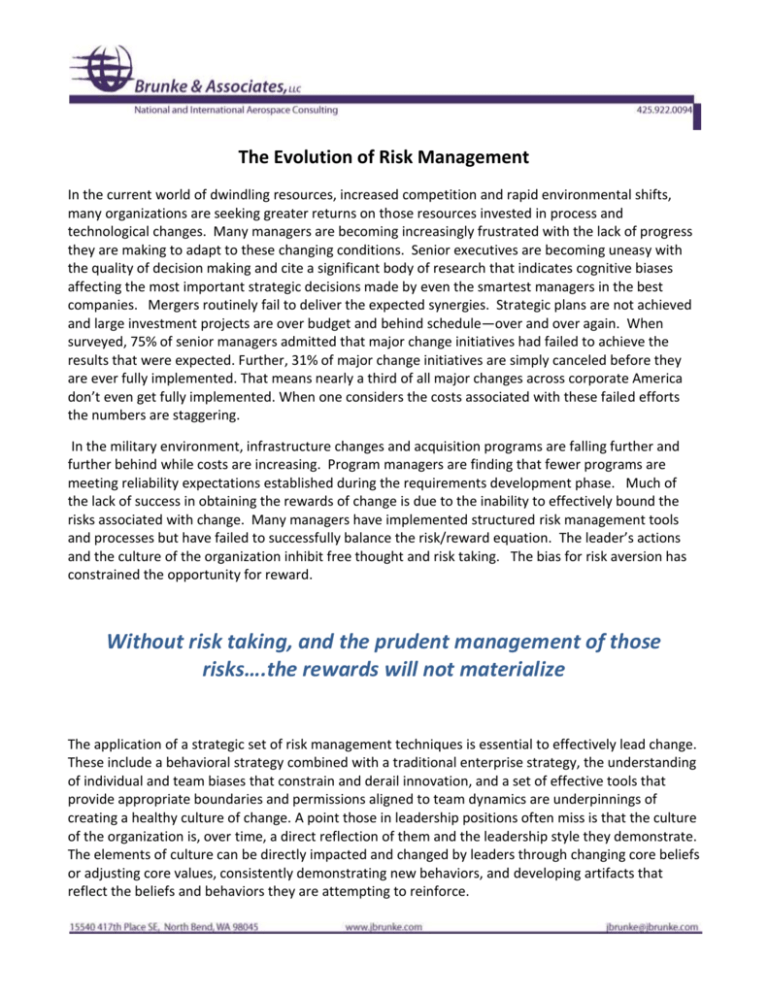
The Evolution of Risk Management In the current world of dwindling resources, increased competition and rapid environmental shifts, many organizations are seeking greater returns on those resources invested in process and technological changes. Many managers are becoming increasingly frustrated with the lack of progress they are making to adapt to these changing conditions. Senior executives are becoming uneasy with the quality of decision making and cite a significant body of research that indicates cognitive biases affecting the most important strategic decisions made by even the smartest managers in the best companies. Mergers routinely fail to deliver the expected synergies. Strategic plans are not achieved and large investment projects are over budget and behind schedule—over and over again. When surveyed, 75% of senior managers admitted that major change initiatives had failed to achieve the results that were expected. Further, 31% of major change initiatives are simply canceled before they are ever fully implemented. That means nearly a third of all major changes across corporate America don’t even get fully implemented. When one considers the costs associated with these failed efforts the numbers are staggering. In the military environment, infrastructure changes and acquisition programs are falling further and further behind while costs are increasing. Program managers are finding that fewer programs are meeting reliability expectations established during the requirements development phase. Much of the lack of success in obtaining the rewards of change is due to the inability to effectively bound the risks associated with change. Many managers have implemented structured risk management tools and processes but have failed to successfully balance the risk/reward equation. The leader’s actions and the culture of the organization inhibit free thought and risk taking. The bias for risk aversion has constrained the opportunity for reward. Without risk taking, and the prudent management of those risks….the rewards will not materialize The application of a strategic set of risk management techniques is essential to effectively lead change. These include a behavioral strategy combined with a traditional enterprise strategy, the understanding of individual and team biases that constrain and derail innovation, and a set of effective tools that provide appropriate boundaries and permissions aligned to team dynamics are underpinnings of creating a healthy culture of change. A point those in leadership positions often miss is that the culture of the organization is, over time, a direct reflection of them and the leadership style they demonstrate. The elements of culture can be directly impacted and changed by leaders through changing core beliefs or adjusting core values, consistently demonstrating new behaviors, and developing artifacts that reflect the beliefs and behaviors they are attempting to reinforce. Three Interconnected Levels of Risk Analysis Organizational level System Complexity •Complex Interactions •Tight Coupling Individual Level Group Level Cognitive Limitations (Bias) Shared Beliefs (Psychological Safety) •Sunk Cost Effect •Overconfidence Bias •Recency Effect •Member Status Differences •Leader Coaching & Support •Level of Familiarity/Prior Interaction Jim Brunke Brunke & Associates, LLC National and International Aerospace Consulting The techniques and tools identified above are essential in the environment of complex organizational systems. Managers are beginning to realize that the shift from managing teams and/or projects is significantly different from facilitating teams in the creation of process change innovation. The leadership challenges have shifted from problem understanding and definition, direction setting, and ultimate decision making to: 1) Balancing competing forces such as overconfidence vs. insufficient confidence; 2) Fostering constructive dissent; 3) Establishing buy in or enthusiasm vs. reluctant obedience; 4) Shaping perceptions and beliefs; and 5) Learning from failure. Leadership must provide a clear picture of what the organization is trying to achieve—the vivid description of the future must be defined and clearly communicated across the organization so people know the vision and direction. The minimum critical boundaries must also be defined so the team is clear on the design space. Skills and capabilities must be developed so they can rapidly respond to changing conditions in the environment. An empowered staff will contribute to the creativity and innovation necessary in today’s global marketplace. The application of a behavioral risk management plan allows teams to innovate more rapidly with less risk than traditional risk management methods. The understanding and application of behavioral strategies have proven that team dynamics and effectiveness are the first step in shifting the risk reward equation. In most of the applications of risk management processes, the risk assessment happens after the fact. The strategy is defined and agreed and then the risk assessment is done (or the decision to upgrade a new technology is decided) and then a risk assessment is conducted. Further, the risks that are identified are typically technical in nature without consideration of what are the greatest risks of all—the acceptance of management and the workforce in actually executing the change. Often the greatest risk is in areas like communication, team development, cultural norms, management capability and not technology. Another Way to Look at the Big Levers Processes Supplier Interaction Centralized vs Decentralized Business Model Organization Technology Intellectual Capital Experience Relationships Organizational Influence Materials Tooling Facilities Jim Brunke Brunke & Associates, LLC National and International Aerospace Consulting Leaders should ensure that the team assessments of risk are realistic and being actively monitored and managed, however the assessment of the larger organizational risks are solely the responsibility of the leader. Assuring the smooth and healthy integration of business model, organization and technology is where the majority of the risks lie. If only one of the big levers change (business model, organization or technology), the risks are manageable by a team. When two or three are changing at the same time, however, the risks associated with the project increase dramatically. Innovation comes from failure with resilience. How we manage our teams, how we view our organization and how we migrate our culture will help us move from an organization of “Prevention of Failure” to an organization that can “Realize, Absorb & Recover From Failure”. Failures stimulate learning, and learning breeds effective change execution and ultimately success. Effective leaders recognize that risk is lessened in organizations where the culture encourages team members to innovate and utilize creativity to address issues. When setbacks do occur, they are immediately brought forward and the lessons learned are used to improve processes and strengthen execution. By recognizing the behavioral component of risk management there is the potential to develop innovation while lessening overall organization risk. Additional thoughts regarding specific risksSupply Chain Management – • Develop a complete end to end supply chain strategy early • Map out the supply chain at multiple levels to identify key risk points • Assist tier I suppliers to mature their supplier oversight, monitoring and performance metrics reporting processes • Develop leading supply chain indicators that identify risks • Build a supply chain organization that can actively monitor and manage multiple networks and linkages across an extended supply chain • Assure the supply chain organization fully understands all the activities coming through the supply chain Team Recommendations – • Develop a complete end to end supply chain strategy early • Map out the supply chain at multiple levels to identify key risk points • Assist tier I suppliers to mature their supplier oversight, monitoring and performance metrics reporting processes • Develop leading supply chain indicators that identify risks • Build a supply chain organization that can actively monitor and manage multiple networks and linkages across an extended supply chain • Assure the supply chain organization fully understands all the activities coming through the supply chain Lean Recommendations – • Know where you are in the program and apply the lean principles as appropriate • Don’t apply lean until you have the process defined and stabilized • Assure the entire value chain is applying lean principles • Determine logical breakpoints • Lean is more about culture than process Global Outsourcing Recommendations – • Recognize that outsourcing doesn’t eliminate the risk • Be sensitive to communications issues • • Focus on vocabulary precision – follow-up with written minutes • Be alert to cultural norms and sensitivities (subtleties) Stay focused on the critical path and value shifters Process Recommendations – • Establish process health metrics for each process • Establish a review schedule for all processes • Review• Effectiveness • Efficiency • Lessons learned from other processes • Process changes in interconnected processes • Training and education adequacy • Recommendations




